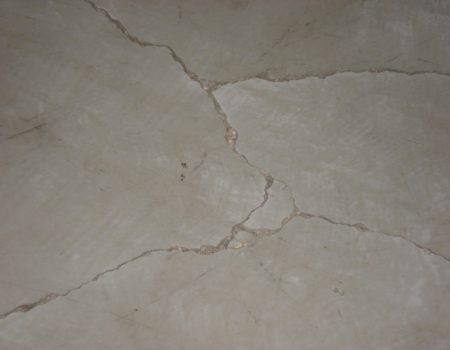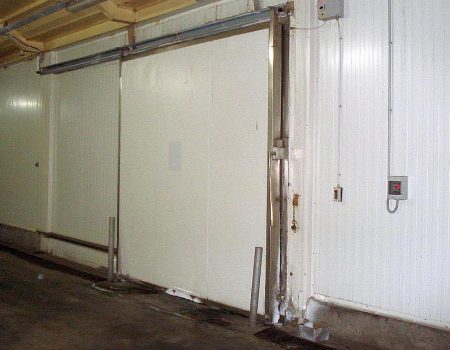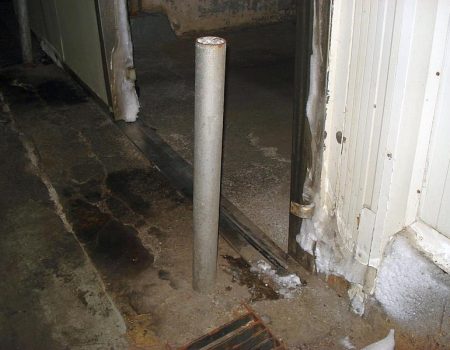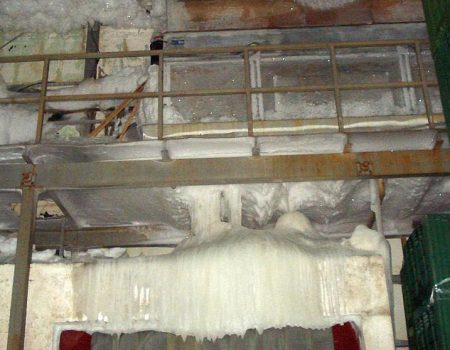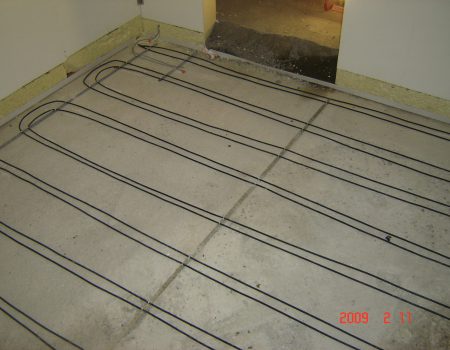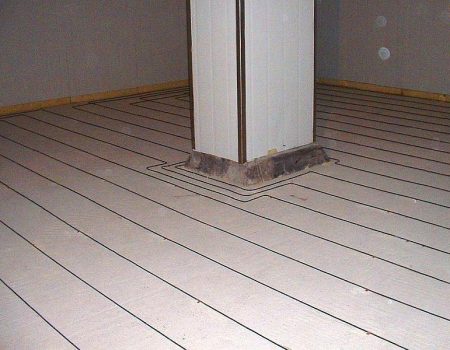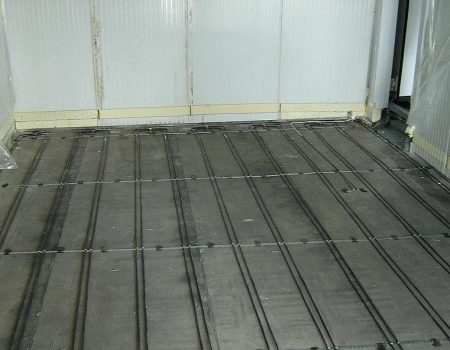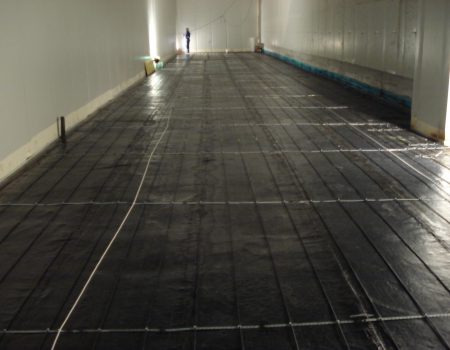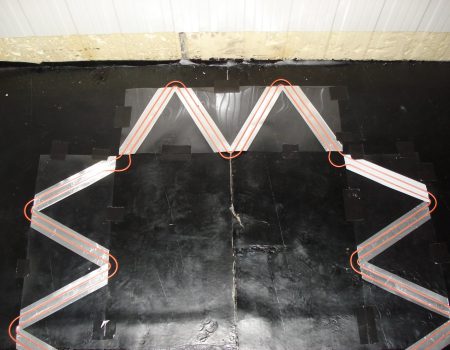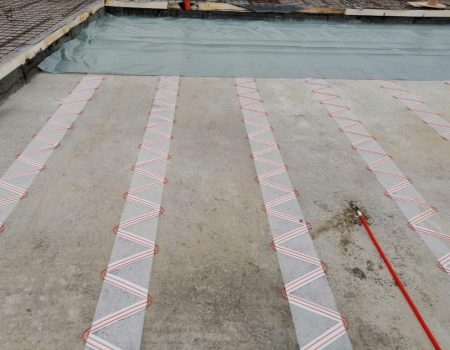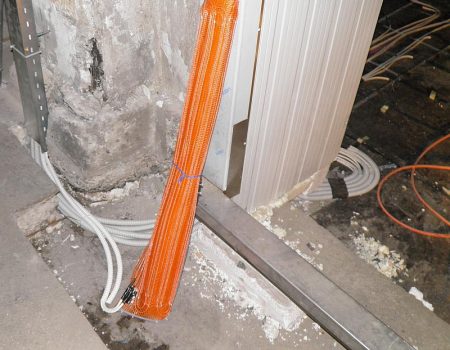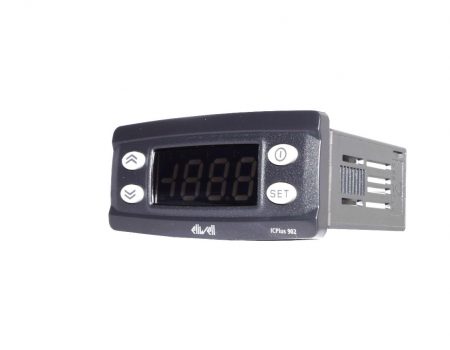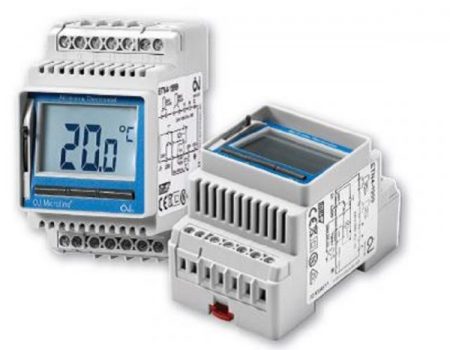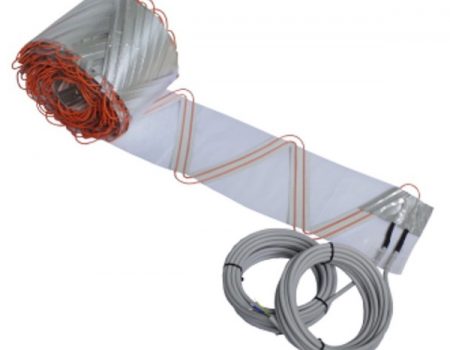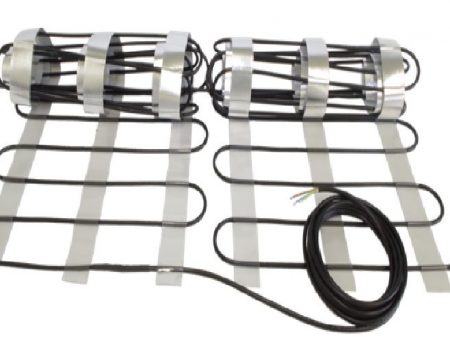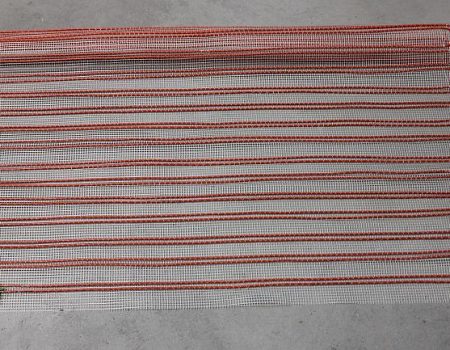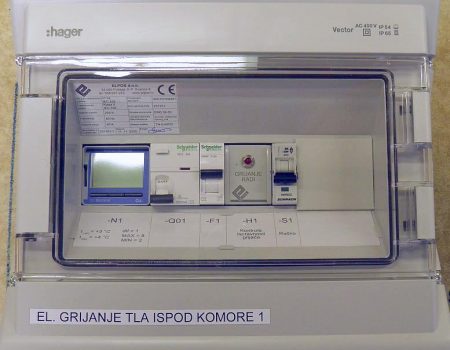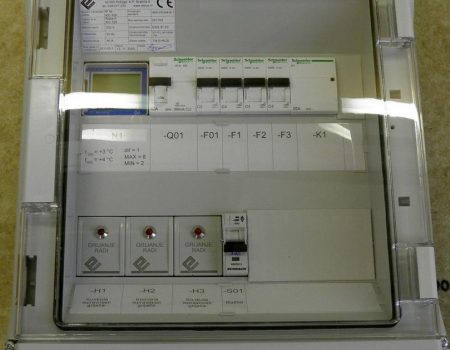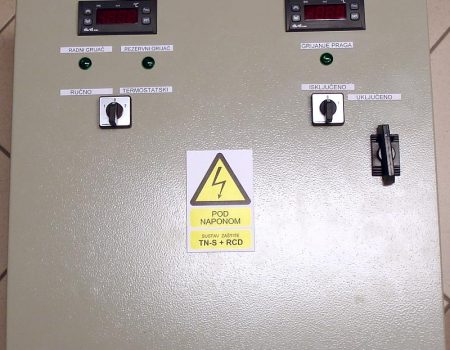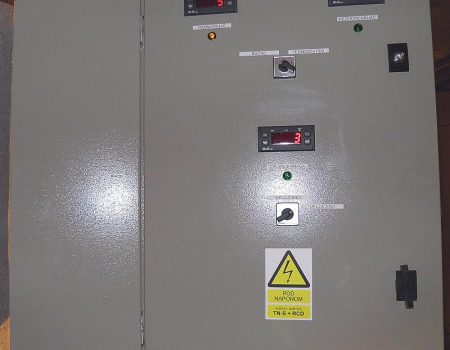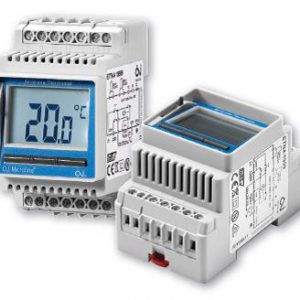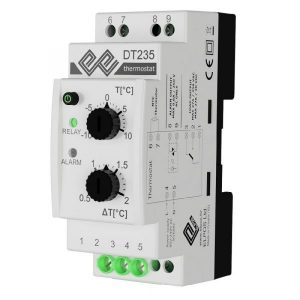Why heat in cold store?
Underfloor heating under the cooling chamber
Calculations show that, at air temperatures in cold rooms of -20 ° C and below, built in the Central European climate zone (soil temperature + 6 ° C at a depth of 3 m), even a gravel embankment of over 5 m (below the floor) or 0.5 m of high quality thermal insulation (in the floor), do not give a 100% guarantee against the occurrence of soil freezing.
In order not to irrationally consume materials, and to safely prevent the destruction of the building, it is necessary to create a “thermal barrier” by heating the floor and ground under the thermal insulation of the cooling chamber. The possibilities of such heating are different (tunnels with hot air, pipelines with hot liquid medium), but from the point of view of investment costs, ease of installation and efficiency of temperature regulation, the most suitable solutions are electric heating cables (usually SSAP type) or heating foils for cold stores ).
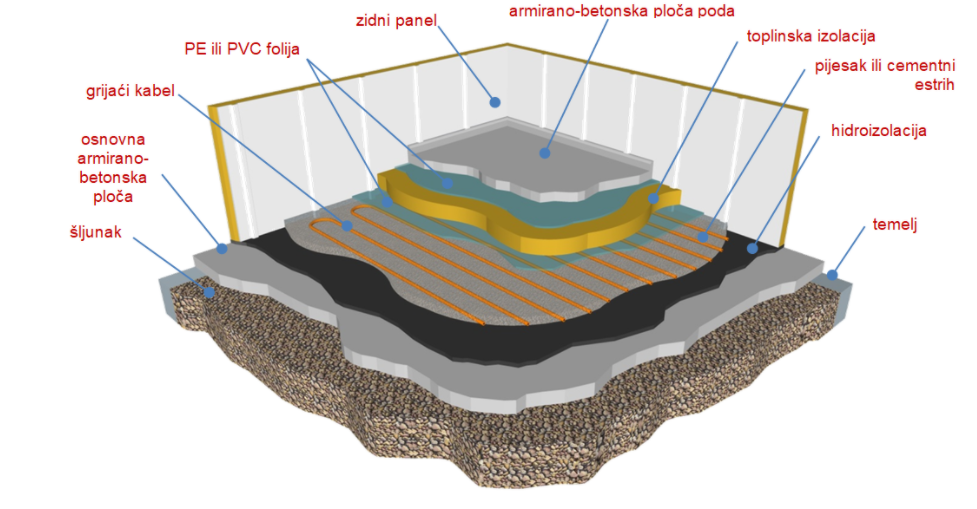
Heating cables are installed on the waterproofing of the basic reinforced concrete slab of the cooling chamber. They are covered with a layer of sand or cement screed, followed by thermal insulation of the floor, PE or PVC foil and a load-bearing reinforced concrete floor slab. Due to the impossibility of subsequent interventions and possible repairs of the heating cables (when the cooling chamber is already working), in addition to WORKING heating cables, SPARE heating cables are always installed in the floor.
Today, instead of individual heating cables, heating foils for cold stores (GFH) are being installed more and more often, since they significantly simplify and speed up the installation time, and thus make the heating of the floor under the cooling chamber cheaper. Of course, heating foils for cold stores have an integrated WORKING and SPARE heating cable. They are very thin (about 5 mm) so they do not have to be covered with sand or cement screed. Thermal insulation (polystyrene) is placed directly on the heating foils for cold stores (GFH).
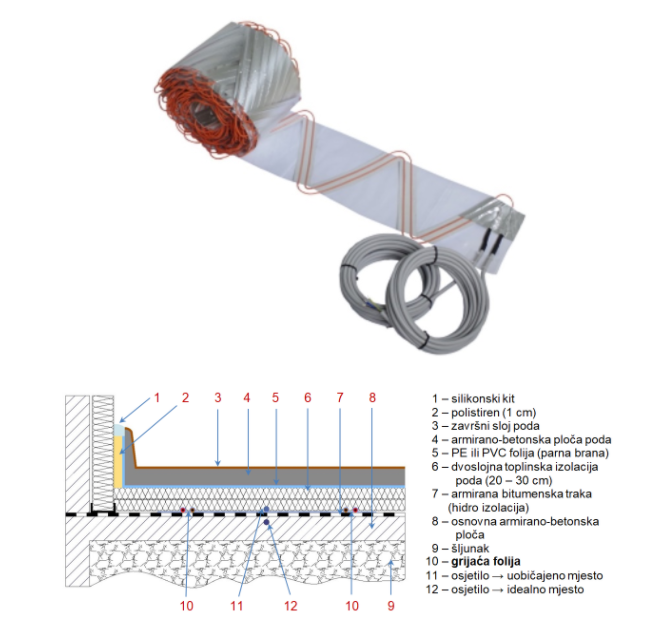
1 – silicone putty, 2 – polystyrene (1cm), 3 – the final layer of the floor , 4 – reinforced concrete floor slab 5 – PE or PVC foil (steam dam), 6 – two-layer thermal insulation of the floor (20-30cm), 7 – reinforced bitumen tape (waterproofing), 8 – basic reinforced concrete slab,, 9 – gravel 10 – heating foil, 11 – thermostat sensor (common place) 12 – thermostat sensor (ideal place)
The required power of soil heating under the cooling chambers for long-term storage of food ranges from 10-25 W/m², and for protection against freezing of the soil under the tunnel for fast freezing of food ranges from 20-35 W/m².
Cooling chamber door threshold zone heating
When opening the cooling chamber door, warmer and more humid air, from the anteroom, enters the cooling chamber and there the moisture condenses very quickly, drips from the ceiling and walls and freezes on the floor. This process is most intense in the area of the threshold of the cooling chamber door, so that a dangerous ice film is formed on that part of the floor, and the door seals stick and tear when the door is opened.
To protect the threshold, door and the area around the door from sticking and ice formation, heating tracks of the cooling chamber threshold (GTPH) or thin heating mats for cooling chamber (TGMtH) are installed in the concrete floor layer 3 to 5 cm from the top of the finished floor. Heating tracks have a unit power of 340 W/m², while heating mats have a unit power of 300 W/m².
Heating tracks are produced in dimensions that cover all widths of refrigerator door openings in the range of 1 to 3 m. Heating tracks are made of two-core, classic, electric heaters, SSAP type, very robust construction and long service life. Therefore, the need for the installation of an additional – SPARE heating trace is questionable, but from the point of view of greater safety, it is still recommended.

The heating track installed in the floor of the entrance zone of the cooling chamber door must have its own temperature regulation. The measuring sensor, or rather measuring sensors (WORKING and SPARE) are installed between two heaters, at the depth of installation of the complete heating trace, which is 3 to 5 cm from the top of the finished floor of the cooling chamber. The measuring sensors are always located on the part of the floor inside the cooling chamber and the temperature at which the floor should be heated is 5 ° C or higher. For this purpose, it is convenient to use electronic thermostats with temperature adjustment potentiometers and NTC temperature sensors (eg “Elpos” DT235).
The same rules for installation and operation control apply to the use of thin heating mats TGMtH for the cooling chambers, which always have both a WORKING and a SPARE heating cable. Their standard width is 1 m, and the lengths are aligned with the openings of the cooling chamber doors.
Heating the door frames of the cooling chamber
In order not to “glue” the rubber door seal to the door jamb and tear it, when opening the door, it is necessary to heat the area where the seal fits on the door jamb with a power of 15 to 30 W/m. The most difficult case is when the temperature in the cooling chamber is low (-20 to -30 ° C), and in the hallway around 0 °C, because then the so-called “wet freezing” with lots of ice. In this case, it is desirable to heat with a higher power than specified (eg 40 W/m), with mandatory temperature control with a thermostat. Doors that open infrequently (eg once a week or less often) do not need to have continuous heating, but stronger heaters (40 to 80 W/m) should be installed and switched on only before opening the door. Heating cables are installed on the inside of the jamb and sill (in the appropriate slots or glued with aluminum tape or, less frequently, by pulling into the rubber door seal.
Resistive wire heating cables type TCT or self-regulating heating cables type SRF can be used to heat the door frames of the cooling chamber.
Heating the defrostat drain from the cooling chamber
The collecting vessels for iced water under the evaporator and the defrostat drain pipes must be heated to prevent re-icing of the newly melted ice from the evaporator. Heating of collecting vessels (as well as evaporators) is mainly done with pipe heaters, and heating of drain pipes with heating cables. On metal pipes, heating cables, type SSAP, are laid directly, and in the case of plastic pipes, the pipes should first be wrapped with aluminum foil, and only then the heater should be installed. Excellent results are also achieved by installing self-regulating heating cables, type SRF 40, in the defrostat drain pipes themselves. Regardless of the type of heating cable and the method of installation, the pipe must have thermal insulation of the appropriate type (eg “Armaflex” AF) and thickness.
MANAGEMENT WITH UNDERFLOOR HEATINHG UNDER THE COOLING CHAMBER
In order to achieve the desired temperature (approx. 3 °C), reduce operating costs and protect heating cables or heating foils from overheating, it is necessary to monitor and manage their operation. For control and management of underfloor heating, we recommend electronic thermostats with digital temperature display (ICPlus 902 or ETN4-1999) or without digital temperature display (DT235). From the point of view of reliability, it is desirable to install a safety thermostat in addition to the working thermostat, and as a minimum of safety to install a working and backup temperature sensor.
In electrical control boxes for controlling the operation of heating cables or heating foils for underfloor heating (RGH), which we make, we must install a circuit with a current transformer and LED for continuous control of the correctness of installed heaters. Also in control boxes we install electric heaters to prevent moisture condensation.
MANAGMENT OF HEATING DOOR JAMBS AND DEFROSTAT DRAIN
We recommend highly reliable thermostats type DT235 to control the operation and ensure the appropriate temperature of the door jambs and defrostat drains.
When heating a defrostat drain, refrigeration technicians often use automation that includes defrosting of the evaporator also to control the heating of the defrostat drain.
How to solve heating in the cold store?
When we made the first electric floor heating under the cold store in Bošnjaci in 1994, we had no idea that in the next period, we would install and deliver equipment for over a hundred of them. The biggest progress and jump in the delivery of equipment occurred when we produced foil heaters for cold stores type GFH and completed them with the corresponding electrical boxes type RGH. In this way, we have facilitated, accelerated and reduced the cost of this type of heating. No special knowledge and skills were needed to make them, but only adherence to the plan for the installation of heating foils and the usual knowledge of the electrical profession. The fact that we installed the last heating in the cold store back in 2010 shows how normal this job has become for all installation companies. Therefore, it is enough to send us a floor plan or floor plans of cooling chambers with the indicated dimensions, positions and directions of opening the cooling chamber door and we will make proposals for heating solutions, and upon their acceptance, the complete necessary equipment.
What products do we offer?
- resistive wire heating cable type SSAP
- for heating the ground under the cooling chambers
- resistive wire heating cables type TCT
- for heating the cooling chamber door jambs
- self-regulating heating cable type SRF
- for heating the defrostat drain
- heating foils type GFH
- for heating the ground under the cooling chambers
- thin heating mats type TGMtH
- for heating in the threshold zone of the cooling chamber door
- heating traces type GTPH
- for heating in the threshold zone of the cooling chamber door
- thermostats with associated measuring sensors
- ETN4-1999 for controlling underfloor heating under the cooling chamber
- ICPlus 902 for controlling underfloor heating under the cooling chamber
- DT235 for controlling the operation of the threshold zone, door jamb and defrostat drain heating
- mounting material sheet
- metal mounting strips with a perforation pitch of 10 and 20 mm
In addition to the listed individual equipment, which has already been shown in the photos in the previous chapters, we also supply sets of control manifolds for specific refrigerators.
Other information related to the topic of heating in cold stores can be found in the following documents:
Cold stores – principles
Cold stores – installation of GFH
GTPH – heating traces of the cooling chamber threshold
TGMtH – heating mats for cold stores
RGH – control boxes for el. heating in cold stores
INQUIRY FORM with an example for taking measures – heating in cold stores
If you have questions related to electric heating in cold stores, feel free to contact us.

